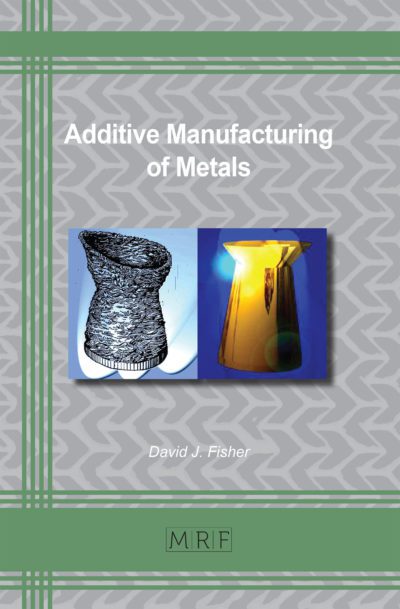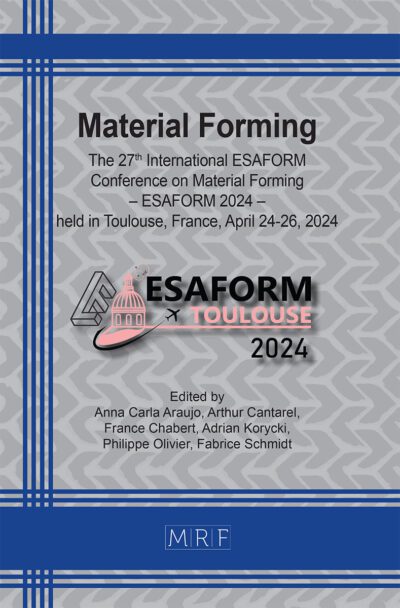Investigation of the mechanical properties of embossed sheet metals materials under static and dynamic loads
Pascal Heinzelmann, Michael Vöhringer, Kim Rouven Riedmüller, Mathias Liewald
Abstract. Lightweight construction still represents an approach pursued in the automotive industry to improve vehicle resources and energy efficiency. However, car manufacturers must also ensure that the mechanical crash properties are maintained for passenger safety. To meet these two requirements, heavy crash-relevant sheet metal components made of high-strength aluminium alloys or dual-phase steels can be designed to be thinner and thus lighter by selectively modifying the mechanical properties in relevant areas. Here, the introduction of near-surface embossing provides a promising approach. Therefore, tensile as well as three-point bending tests performed with specimens from the dual-phase steel grades DP600 and DP800 have already shown that mechanical properties such as tensile and bending strength can be specifically adjusted to enhance crash performance by near-surface embossing depending on the embossing distance and depth. However, near-surface embossing has only been investigated in static tests so far. No studies have been carried out on how the mechanical properties change under dynamic loading, which is important for crash-relevant components. Against this background, this paper investigates and analyses static and dynamic compression load profiles applied to rectangular bent and embossed specimens from DP600 and Al6014. These tests were carried out on the Dynamic Systems Gleeble 3800c materials testing machine at speeds of up to 250 mm/s. The test results revealed that near-surface embossing significantly affects the material properties of sheet metal materials in both static and dynamic cases.
Keywords
Dynamic Testing, Dual-Phase Steel, Aluminium, Near-Surface Embossing
Published online 5/7/2025, 9 pages
Copyright © 2025 by the author(s)
Published under license by Materials Research Forum LLC., Millersville PA, USA
Citation: Pascal Heinzelmann, Michael Vöhringer, Kim Rouven Riedmüller, Mathias Liewald, Investigation of the mechanical properties of embossed sheet metals materials under static and dynamic loads, Materials Research Proceedings, Vol. 54, pp 1182-1190, 2025
DOI: https://doi.org/10.21741/9781644903599-129
The article was published as article 129 of the book Material Forming
![]() Content from this work may be used under the terms of the Creative Commons Attribution 3.0 license. Any further distribution of this work must maintain attribution to the author(s) and the title of the work, journal citation and DOI.
Content from this work may be used under the terms of the Creative Commons Attribution 3.0 license. Any further distribution of this work must maintain attribution to the author(s) and the title of the work, journal citation and DOI.
References
[1] K. Shanmugam, V. Gadhamshetty, P. Yadav, D. Athanassiadis, M. Tysklind, and V. K. Upadhyayula, “Advanced High-Strength Steel and Carbon Fiber Reinforced Polymer Composite Body in White for Passenger Cars: Environmental Performance and Sustainable Return on Investment under Different Propulsion Modes,” ACS Sustainable Chem. Eng., vol. 7, no. 5, pp. 4951–4963, 2019. https://doi.org/10.1021/acssuschemeng.8b05588.
[2] H. E. Friedrich, Leichtbau in der Fahrzeugtechnik. Wiesbaden: Springer Fachmedien Wiesbaden, 2017.
[3] C. S. Namoco, T. Iizuka, R. C. Sagrado, N. Takakura, and K. Yamaguchi, “Experimental and numerical investigation of restoration behavior of sheet metals subjected to bulging deformation,” Journal of Materials Processing Technology, vol. 177, 1-3, pp. 368–372, 2006. https://doi.org/10.1016/j.jmatprotec.2006.03.208.
[4] C. S. Namoco, T. Iizuka, K. Narita, N. Takakura, and K. Yamaguchi, “Effects of embossing and restoration process on the deep drawability of aluminum alloy sheets,” Journal of Materials Processing Technology, vol. 187-188, pp. 202–206, 2007. https://doi.org/10.1016/j.jmatprotec.2006.11.182.
[5] Y. Abe, K. Mori, T. Maeno, S. Ishihara, and Y. Kato, “Improvement of sheet metal formability by local work-hardening with punch indentation,” Prod. Eng. Res. Devel., vol. 13, no. 5, pp. 589–597, 2019. https://doi.org/10.1007/s11740-019-00910-6.
[6] S. Walzer and M. Liewald, “Studies on the influence of embossing on the mechanical properties of high-strength sheet metal,” Proceedings of the 22nd International ESAFORM Conference on Material Forming (ESAFORM 2019), vol. 2113, no. 1, p. 160006, 2019. https://doi.org/10.1063/1.5112703.
[7] D. Briesenick, S. Walzer, and M. Liewald, “Study on the Effect of Embossing on the Bending Properties of High-Strength Sheet Metals,” in Forming the Future: Proceedings of the 13th International Conference on the Technology of Plasticity (The Minerals, Metals & Materials Series), G. Daehn, J. Cao, B. Kinsey, E. Tekkaya, A. Vivek, and Y. Yoshida, Eds., 1st ed. Cham: Springer International Publishing; Imprint Springer, 2021, pp. 2585–2595.
[8] P. Heinzelmannn, D. Briesenick, and M. Liewald, “Modifying mechanical properties of sheet metal materials by work hardening mechanisms induced by selective embossing,” in Material Forming, Lukasz Madej, Mateusz Sitko, and Konrad Perzynski, Eds., 2023, pp. 951–958. https://doi.org/10.21741/9781644902479-104.
[9] P. Heinzelmann, D. Briesenick, and M. Liewald, “Characterization of the Mechanical Properties of Selectively Embossed Sheet Metal Materials Under Multi-Axial Loads,” IOP Conf. Ser.: Mater. Sci. Eng., vol. 1284, no. 1, p. 12043, 2023. https://doi.org/10.1088/1757-899X/1284/1/012043.
[10] P. Henn, M. Liewald, and M. Sindel, “Characterising ductility of 6xxx-series aluminium sheet alloys at combined loading conditions,” AIP Conf. Proc., vol. 1896, no. 1, p. 20008, 2017. https://doi.org/10.1063/1.5007965.
[11] H. Hooputra, H. Gese, H. Dell, and H. Werner, “A comprehensive failure model for crashworthiness simulation of aluminium extrusions,” International Journal of Crashworthiness, vol. 9, no. 5, pp. 449–464, 2004. https://doi.org/10.1533/ijcr.2004.0289.
[12] K. Siebertz, D. van Bebber, and T. Hochkirchen, Statistische Versuchsplanung: Design of Experiments (DoE), 2nd ed. (VDI-Buch). Berlin, Heidelberg: Springer Vieweg, 2017.














